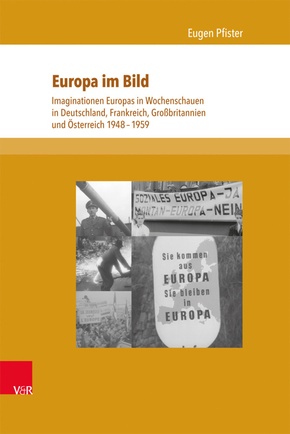Europa im Bild - Imaginationen Europas in Wochenschauen in Deutschland, Frankreich, Großbritannien und Österreich 1948-1959. Dissertationsschrift
| Verlag | V&R unipress |
| Auflage | 2014 |
| Seiten | 372 |
| Format | 15,5 x 23,8 x 3,2 cm |
| Gewicht | 666 g |
| Reihe | Schriften zur politischen Kommunikation Band 014 |
| ISBN-10 | 3847101986 |
| ISBN-13 | 9783847101987 |
| Bestell-Nr | 84710198A |
Europa auf der Leinwand. Die politische Kommunikation des europäischen Integrationsprozesses außerhalb der intelektuellen Elite
Welche Bilder machten sich EuropäerInnen von Europa? Von dieser Frage ausgehend untersucht Eugen Pfister österreichische, französische, deutsche und britische Wochenschauen der Nachkriegszeit: Viele EuropäerInnen machten sich im Kino ein erstes »Bild« von den europäischen Gemeinschaften, das im weiteren Verlauf zur Grundlage ihrer Meinungen und Überzeugungen wurde. Dies gilt insbesondere für die ArbeiterInnen und KleinbürgerInnen Europas, deren Wahrnehmung des Integrationsprozesses von der Integrationsforschung bisher kaum beachtet wurde. Für eine Rekonstruktion des Europadiskurses jenseits intellektueller Zirkel bieten Wochenschauen deshalb eine lohnende Untersuchungsquelle. Pfister zeigt zudem, dass die audiovisuelle Repräsentation Europas der 1950er Jahre als ökonomische und politische Gemeinschaft nicht nur das Ergebnis eines politischen Diskurses ist, sondern immer auch einer ikonographischen Tradition verpflichtet war.
Cinema Newsreels provide a unique and up until now neglected opportunity to examine the beginning of the European integration (1949 1958) in the media of the post-war period. Newsreels were important in shaping opinions, especially by creating powerful images. This book aims at analysing and classifying these images and concepts proposed identities of the European integration in Austria, France, Germany and Great Britain of the the 1950s, especially by comparing the specific methods of photography and filmmaking used to produce a certain perception in the audience.
These newsreel items are not only records from the beginning and consolidation of the European integration but also political instruments. On the one hand, they informed a wider public about the new institutions, their purposes as well as their decision-making procedures; on the other hand, they intended to propagate a European identity. This audiovisual representation of Europe as a economical and political communit y, or, respectively the idea of European integration , was not only a result of a political discourse but also a continuation of a centuries-old iconographic tradition.

